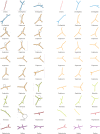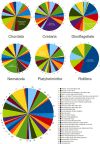The spliced leader trans-splicing mechanism in different organisms: molecular details and possible biological roles
- PMID: 24130571
- PMCID: PMC3795323
- DOI: 10.3389/fgene.2013.00199
The spliced leader trans-splicing mechanism in different organisms: molecular details and possible biological roles
Abstract
THE SPLICED LEADER (SL) IS A GENE THAT GENERATES A FUNCTIONAL NCRNA THAT IS COMPOSED OF TWO REGIONS: an intronic region of unknown function (SLi) and an exonic region (SLe), which is transferred to the 5' end of independent transcripts yielding mature mRNAs, in a process known as spliced leader trans-splicing (SLTS). The best described function for SLTS is to solve polycistronic transcripts into monocistronic units, specifically in Trypanosomatids. In other metazoans, it is speculated that the SLe addition could lead to increased mRNA stability, differential recruitment of the translational machinery, modification of the 5' region or a combination of these effects. Although important aspects of this mechanism have been revealed, several features remain to be elucidated. We have analyzed 157 SLe sequences from 148 species from seven phyla and found a high degree of conservation among the sequences of species from the same phylum, although no considerable similarity seems to exist between sequences of species from different phyla. When analyzing case studies, we found evidence that a given SLe will always be related to a given set of transcripts in different species from the same phylum, and therefore, different SLe sequences from the same species would regulate different sets of transcripts. In addition, we have observed distinct transcript categories to be preferential targets for the SLe addition in different phyla. This work sheds light into crucial and controversial aspects of the SLTS mechanism. It represents a comprehensive study concerning various species and different characteristics of this important post-transcriptional regulatory mechanism.
Keywords: RNA secondary structure; RNA sequence analysis; non-coding RNAs; spliced-leader; trans-splicing.
Figures





References
LinkOut - more resources
Full Text Sources
Other Literature Sources
Research Materials

